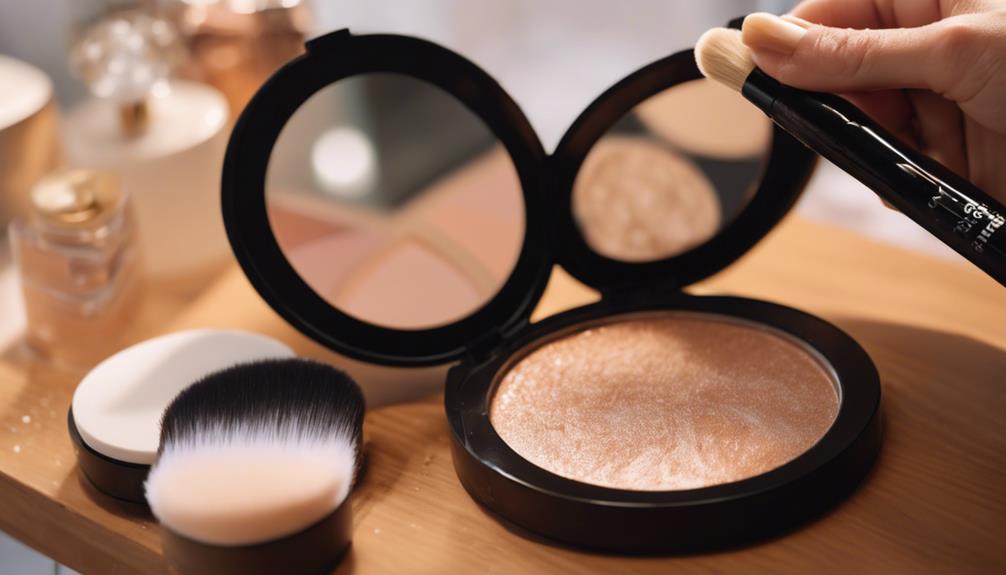To achieve a sun-kissed glow, it is important to understand your skin undertones: warm, cool, or neutral. Choose a bronzer that matches your undertone; warm tones should go for golden hues while cool tones should opt for rose-gold. When applying bronzer, select a shade slightly darker than your foundation and focus on areas like your cheekbones, forehead, and nose. For longevity, consider using powder bronzers for oily skin and cream bronzers for dry skin. Don’t forget to follow up with a hydration routine to keep your glow. Explore more tips on how to achieve and maintain a radiant look all year round.
Key Takeaways
- Determine your skin undertone (warm, cool, neutral) to select the most flattering bronzer shade for a natural sun-kissed look.
- Choose bronzers one to two shades darker than your foundation, applying to high points like cheekbones, temples, and nose for definition.
- Opt for powder bronzers for oily skin or cream bronzers for dry skin to ensure a long-lasting, radiant finish.
- Maintain your tan's vibrancy with hydrating moisturizers, sulfate-free cleansers, and gentle exfoliation to prevent uneven fading.
Understanding Skin Undertones
Understanding skin undertones is essential for selecting the right bronzer, as these subtle hues beneath the skin's surface greatly influence the overall warmth and harmony of your makeup look.
Skin undertones generally fall into three categories: warm, cool, and neutral. Warm undertones exhibit yellow or golden shades, while cool undertones display pink or red hues. Neutral undertones blend characteristics from both categories.
Identifying your undertone can be accomplished through various methods, such as the jewelry test—where silver typically suits cool undertones and gold complements warm tones.
Selecting bronzer shades that align with your undertone enhances your complexion, ensuring a natural and radiant finish. Proper understanding of undertones is foundational for achieving the desired sun-kissed glow.
Selecting the Right Bronzer
Choosing the right bronzer involves considering your skin undertone, which is essential for achieving a natural and harmonious sun-kissed look.
For those with warm undertones, bronzers in honey or golden hues will enhance the complexion. Individuals with cool undertones should opt for rose-gold or soft terracotta shades, which complement their skin's natural tones.
Darker skin tones benefit most from deep, rich bronze colors that provide a stunning contrast.
Additionally, it's important to remember that skin tones can fluctuate seasonally, necessitating adjustments in bronzer shades.
Conducting a jewelry test—gold for warm undertones and silver for cool—can further aid in selecting the ideal bronzer, ensuring a flawless finish that enhances your natural beauty.
Bronzer Application Techniques

Mastering effective bronzer application techniques is essential for achieving a natural and radiant sun-kissed glow.
Begin by selecting a bronzer that is one or two shades darker than your foundation, ensuring it complements your skin undertones.
Use a fluffy brush to apply bronzer lightly to the high points of your face—cheekbones, temples, and nose bridge. Start with a small amount, building gradually to avoid an overly bronzed appearance.
Blend thoroughly to eliminate any harsh lines, creating a seamless shift between bronzer and foundation.
For added dimension, consider incorporating highlighter on the cheekbones and brow bones.
The key is to enhance your natural features while maintaining a soft, glowing finish, ensuring a perfectly sun-kissed look.
Long-Lasting Bronzer Options
Selecting a long-lasting bronzer requires careful consideration of skin undertones and type to guarantee ideal wear throughout the day.
For those with oily skin, powder bronzers are best, providing a matte finish that resists shine. Conversely, individuals with dry skin may benefit from cream bronzers, which offer hydration and a dewy appearance.
When choosing shades, it's important to select bronzers one to two shades darker than your natural skin tone, ensuring a natural sun-kissed effect. Additionally, consider the undertone; warm undertones pair well with golden hues, while cool undertones are complemented by rose or pink tones.
Liquid bronzers can enhance the look, but for longevity, powder or cream formulations are often preferred for their staying power.
Mastering Placement Techniques

Effective bronzer placement is essential for achieving a natural-looking, sun-kissed glow that enhances facial structure and warmth.
To master this technique, focus on applying bronzer to the high points of your face, where the sun would naturally hit. This not only adds dimension but also creates a radiant finish.
- Apply bronzer to the forehead and above the brows for a sun-kissed appearance.
- Dust bronzer lightly on the cheekbones to accentuate natural contours.
- Sweep along the jawline for a defined look.
Post-Tanning Skin Care
Post-tanning skin care is essential for maintaining a healthy, radiant complexion and prolonging the effects of your bronzer.
Begin with a gentle cleanser to remove makeup and impurities, ensuring that your skin's natural oils remain intact.
Following cleansing, apply a hydrating moisturizer to lock in moisture and promote a smooth surface for bronzer application.
Look for products containing aloe vera or hyaluronic acid, known for their soothing properties.
Additionally, consider incorporating an after-tan lotion specifically designed to nourish and rejuvenate post-tan skin.
This routine helps mitigate dryness and peeling, ultimately enhancing the longevity and vibrancy of your sun-kissed glow.
Consistent care is key to achieving and maintaining your desired complexion.
Enhancing Your Tan Longevity

Maintaining a radiant complexion after tanning requires a strategic approach to enhance the longevity of your tan. To prolong your sun-kissed glow, implement the following tips:
Hydration: Drink plenty of water and apply moisturizing lotions to keep your skin supple.
Gentle Cleansing: Use sulfate-free cleansers that do not strip natural oils from the skin.
Avoid Exfoliation: Refrain from harsh scrubs that can diminish your tan and cause uneven fading.
Sun Protection: Apply a broad-spectrum sunscreen daily to shield your skin from UV damage and maintain color integrity.
Why is Hydrating Important for Achieving a Sun-Kissed Glow?
Hydrate for flawless tan by ensuring your skin remains moisturized. Proper hydration helps maintain your skin’s elasticity and prevents dryness, which can lead to a dull complexion. By keeping your skin well-hydrated, you can achieve a sun-kissed glow that looks radiant and healthy, enhancing your overall appearance.
Conclusion
Achieving a sun-kissed glow requires informed choices in bronzer selection and application techniques.
Research indicates that 80% of individuals find that a bronzer enhances their overall complexion, underscoring the product's significance in makeup routines.
Proper understanding of skin undertones, coupled with effective bronzer placement and post-tanning care, can greatly elevate one's aesthetic.
By implementing these strategies, individuals can cultivate a radiant appearance while promoting skin health, ultimately achieving the desired sun-kissed effect.










